Sports Biomechanics
Biomechanics is the study of human movement including the interaction between the participant and equipment.
Primarily these studies are broken down into two broad areas:
- kinetics (the study of forces acting on the body)
- kinematics (the study of movements of the body)
Biomechanics in sport and exercise
Biomechanics uses techniques including mathematical modelling, computer simulations, and measurements to enhance sport performance and reduce injury. It can be applied to a wide variety of sport and exercise activities in order to:
- Identify optimal movement patterns to improve sport-specific techniques.
- Analyse muscular recruitment and loading to determine the safest method of performing a particular task/movement.
- Assist in developing proper movement habits which can be maintained long term (maximising performance and minimising injury risk).
- Analyse sport and exercise equipment e.g. shoes, surfaces, racquets, etc.
Biomechanical testing can take place in the lab or in the field, during training or competition. There are a wide variety of testing procedures in biomechanics depending on the sport and the skill within the sport. Testing methodology is determined based on the problem that needs to be answered and in consultation with the coach and athlete. Some typical biomechanical testing methods are:
- 3D Analysis. Appropriate for many sports especially those involving complex body movements and where very accurate, detailed information is needed. Typically, 3D analysis is done using high speed 3D motion analysis systems in a lab.
- Force Plate Analysis. Generally used for analysing walking, running, and landing activities and used in conjunction with 3D motion analysis systems. Useful for determining impact, braking, and propulsive forces; calculating joint kinetics; and weight transfer in dynamic activities.
- High Speed Video Analysis. High speed cameras, such as Photron, can operate up to 1000Hz. Very useful for qualitative analysis of high-speed movements and impacts.
- Electromyography (EMG). Used for measuring muscle activity. Often combined with 3D motion analysis and force plate testing. Mostly used for higher level analysis.
- Competition Analysis. Competition analysis where relevant performance variables are determined, e.g. in athletics: split times, stride rate/length; in rowing/kayaking: splits, stroke length/rate.
- Accelerometers, Gyroscopes, and Lasers. Used to determine the technical characteristics of an athlete’s motion.
Groups, societies and professional bodies
Vocational educational training
The path to becoming a biomechanist can be varied. The main path is generally via an undergraduate degree in Human Movement, Sport, Exercise Science, Biomedical Engineering, or similar, then progressing to a PhD by way of an Honours or Master’s degree in biomechanics.
Typically, substantial progress towards, or completion of, a PhD in the biomechanics field is needed to be competitive for sports biomechanics jobs.
Due to the limited number of positions in sports biomechanics a common question is “How do I get experience in the field?" Post-graduate scholarships are particularly valuable for developing applied lab and in-field skills vital for a sports biomechanist. You can monitor potential opportunities on the Clearinghouse for Sport Recruitment page.
Accreditation
Accreditation is required for individuals providing services to National Sporting Organisations (NSOs) and the National Institute Network (NIN).
ESSA provides accreditation at two levels: Accredited Sports Scientist Level 1 (ASpS1) and Accredited Sports Scientist Level 2 (ASpS2)
Standards
In August 2020 the Australian Institute of Sport (AIS) released the Sports Science Sports Medicine Practitioner Minimum Standards. These standards represent the mandatory minimum standards for Sport Science Sports Medicine (SSSM) staff and contractors providing services to National Sporting Organisations (NSOs) that are subject to the AIS SSSM Best Practice Principles via their Sport Investment Agreement. Additionally, they will inform the minimum personnel requirements for the National Institute Network (NIN) in SSSM.
Biomechanics standard
- Professional Qualifications: Bachelor’s degree in Exercise, Sports or Movement Science, Sports Engineering, or an allied field
- Professional Accreditations: ESSA Accredited Sports Scientist (ASpS) Level 1
The AIS develops evidence-based position statements on new and complex topics in sports science and sports medicine to provide guidance and leadership for the Australian high performance sports system.
Research and Resources
Last updated: 10 May 2024
Content disclaimer: See Clearinghouse for Sport disclaimer
IS THIS INFORMATION COMPLETE?
The Clearinghouse for Sport is a sector-wide knowledge sharing initiative, and as such your contributions are encouraged and appreciated. If you would like to suggest a resource, submit a publication, or provide feedback on this topic, please contact us.
Alternatively, if you would like to be kept up to date with research and information published about this topic, please request a research profile setup.








